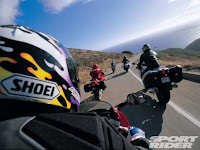One of the most basic techniques of motorcycle riding is to keep your head up and look where you are going. From a safety standpoint, this helps you avoid target fixation; in terms of performance, looking far ahead effectively slows things down, giving you more time to process what you see and take action. The question becomes, then, how do you see something near-like a reference point on the pavement-when you are supposed to be looking far ahead? The answer is that you must use your peripheral vision.
Peripheral vision is the ability to see objects and motion outside of the direct line of sight. Many sports rely on good peripheral vision; a baseball or soccer player must be able to look directly at the ball while seeing as many of the other players around him as he can, for example. Good jugglers don't look at any of the objects being juggled, but rather stare at a spot in space, relying solely on peripheral vision to see all the chainsaws (yikes!) at once.
Typically, you get the most information about something you are directly looking at. The further away something is from this direct line of sight, the less you are able to discern about it. When you take your driving test at the DMV, your peripheral vision is tested by gradually moving a light around your direct line of sight. While we're concerned with something simple like seeing a light off to the side, we're also interested in gleaning more information about it. If a car pulls up beside you on the freeway, you want to know exactly how far to the side it is, how fast it's going, and if the person behind the wheel is paying attention. And ideally you'd be able to do this without actually looking at the car. On the racetrack, it's nice to know exactly how close to your ideal line you are without having to stare directly at the front wheel.
You can improve your peripheral vision through exercise, but first it's important that you aren't inadvertently limiting your range. Simple things like your hair or the edge of a balaclava can restrict your vision. When shopping for a helmet, consider the width of the eyeport and how it can affect things. Wear contacts rather than glasses and a dark shield rather than sunglasses, as the frames can block your line of sight considerably. Optometrist Diana Risco points out that "glasses, especially those that have moderate amounts of astigmatism or a progressive lens (a multifocal lens that changes gradually from distance to near but only through the central corridor of the glasses), can be especially difficult with riding since you need to look in the exact area of the glasses for clarity. Contacts move with your eye so that the optical center is always aligned. Contact lenses are ideal for sports."
Your optometrist can perform tests to check your peripheral vision as well as recommend some exercises. We found several sources on the Internet with variations on the following exercise that can help: In a relaxed setting, focus your gaze on a spot directly in front of you-for example, a picture on a wall. Without moving your eyes, concentrate on something just to the side of the spot, such as a second picture beside the first. Without looking directly at the second object, try to discern as much information about it as you can. Gradually work farther away from where you are actually looking, concentrating on each individual object until you are considering things right at the edge of your vision. Work both to the left and right, and don't forget above and below. With practice, you'll get better at discovering more detail about objects farther to the side. For example, you can add movement to the exercise as well by walking down the sidewalk looking straight ahead (where you want to go) but concentrating on what is to each side of you. You'll then want to practice while riding; eventually it will become second nature to quickly and easily see something to the side without actually looking at it.
The implications of improved peripheral vision are fairly obvious in a street setting: you'll be better able to spot potential danger-such as a car pulling out of a driveway-and then react accordingly, all without losing focus of what's directly in front of you. And on the track it will be much easier to pick up and use reference points while keeping your head up and actually looking as far ahead into the corner as possible. There are numerous and more subtle advantages on both venues. For example, keeping tabs on a bike or car directly in front of you using your peripheral vision lets you look at and focus on the upcoming corner or intersection. With continued practice, you'll find more and more uses for peripheral vision, improving your riding on both street and track.

No comments:
Post a Comment